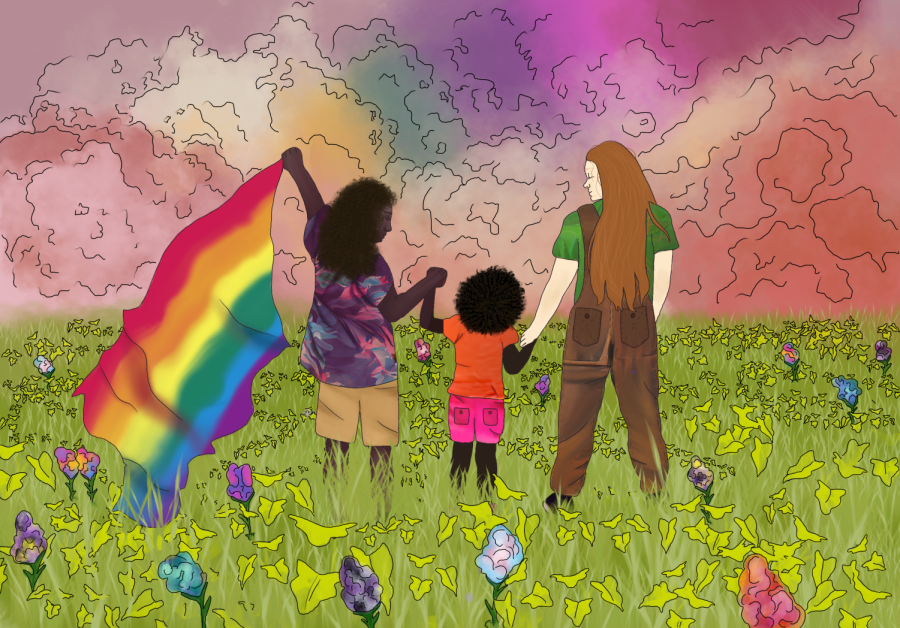Former Minneapolis Mayor R.T. Rybak finished officiating the first same-sex marriage in Minnesota at 11:59 p.m. on July 31, 2013, one minute before a law to legalize it went into effect. Minnesotans are now celebrating a decade of Pride.
Rainbow lights and flowers sat among the white chairs that filled Minneapolis City Hall in preparation for the weddings. Hundreds of people gathered and waited for their turn to walk up the marble staircase covered in garland and white roses and be married on the second floor landing in front of a stained glass window.
The Gay Men’s Chorus sang, “Marry Me,” a song Rybak had heard them perform many times at parades, but as a way of celebrating LGBTQ+ relationships while knowing that marriage for them had always been a “pipe dream.”
As the clock struck midnight and a bell rang in City Hall, Rybak looked at Cathy ten Broeke and their partner Margaret and said, “By the power finally vested in me by the state of Minnesota, I pronounce you legally married.”
“And then it just went nuts,” Rybak said.
For the next six hours, Rybak led a “conveyor belt of love” by officiating a wedding every seven minutes. Between each wedding, Rybak walked down the stairs to sign the now-legal marriage certificates and read about the next couple as he walked back up.
Attendees ranged from college students to couples who had been together for decades, wearing a mixture of colored outfits and three-piece suits.
“We did one wedding after the other, and I personalized every single wedding,” Rybak said. “I was completely choked out by the incredible beauty of it.”
Despite serving for more than a decade as mayor, Rybak said like many of the people he married that night, he did not believe he would see same-sex marriage legalized in Minnesota.
Increasing allyship following a history of “bigotry”
A 1971 Minnesota Supreme Court decision prohibited marriages between same-sex partners, and an appeal to the decision was dismissed by the U.S. Supreme Court. Additionally, a 1977 state law defined a marriage as a civil contract “between a man and a woman.”
Congress passed the Defense of Marriage Act 25 years later, which limited marriage to being legal between one man and one woman. Minnesota passed its own version in 1997. Appeals failed in courts for years, and the state Legislature proposed an amendment to the state constitution prohibiting same-sex marriage in 2011.
The amendment failed in the 2012 elections, but in 2013, former Gov. Mark Dayton signed a bill into law making Minnesota’s marriage law gender-neutral.
The bill went into effect on Aug. 1, making Minnesota the 12th state to legalize same-sex marriage.
“It’s hard to remember that the city we are today actually at one time had a lot of officials who were very bigoted … and [LGBTQ+ people] had to fight like hell for their fair rights,” Rybak said. “I saw the pain of those years and heard from almost everyone, ‘I never expected this would happen.’”
One of the couples Rybak married that night was Nic Zapko, the ASL interpreter for Gov. Tim Walz, and their partner Lisa. As the two signed their vows at 2 a.m. and their kids tossed petals, Zapko said the celebration was “fairytale-like.”
“It was our big moment, our right to legally marry – it was unreal,” Zapko said in an email statement to the Minnesota Daily. “That was the beauty of the night, there was no shortage of inspiration and joy.”
Zapko and their partner were nearing their 12th anniversary before becoming legally married after the two held a “spiritual marriage” in 2001.
Throughout their relationship and even as protestors stood outside City Hall, Zapko said they were unsure if they would ever be married or accepted in Minnesota. Despite there still being “room for improvement” in equality and inclusivity, Zapko said finding allies has become much easier as time has passed.
“It feels much more comfortable, supported and safer to be part of the LGBTQ+ community,” Zapko said. “When we first started dating in the ‘90s, we were very cautious and were not sure we lived in a state that contained so many allies. Now we know we do.”
Andi Otto is the executive director of Twin Cities Pride, an organization aimed at empowering LGBTQ+ people. Otto had to hold off on getting married 10 years ago to wait for it to become legalized in the state.
When that moment came, there was celebration and relief, while acknowledging that “the fight is not over,” Otto said.
Walz signed a bill Thursday making Minnesota a refuge state for those seeking gender-affirming care. The law comes as several states have recently advanced legislation aimed at restricting the rights of transgender people.
“I’m a trans man, and it’s incredibly scary, the legislation that’s coming out and the hate that’s coming toward the community,” Otto said. “We want to celebrate the wins, but sometimes those wins come with a little more hate.”
In the decade since same-sex marriage was legalized in Minnesota, Otto said he has seen the number and attendance of pride celebrations across the state grow significantly.
“If you look at the climate of Minnesota, that wouldn’t have been the case 10 years ago,” Otto said. “The overall feeling of Minnesota is nothing but love and acceptance. We still have our hate in the state, but overall, I would say this is a pretty good place to live.”
This year, Twin Cities Pride’s theme will be “elevate and amplify.” According to Otto, he chose the theme to ensure all LGTBQ+ voices are being heard and prove they are not going anywhere.
“We are a strong community, and we will continue to fight injustice towards our community,” Otto said. “While it’s great to celebrate and we will celebrate wholeheartedly, we have to continue to keep our hand on the pulse and make sure we aren’t quiet when times call for it.”








